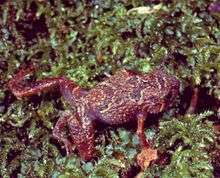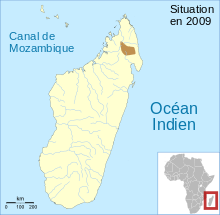Rhombophryne serratopalpebrosa
Rhombophryne serratopalpebrosa is a species of frog of the Madagascar endemic microhylid subfamily Cophylinae.[2] Genetic evidence revealed that it is a species complex, in need of resolution. This work has made significant progress, and five related species have been described from this complex between 2014 and 2017.[3][4][5] It is threatened by habitat loss.[3][5][1]
| Rhombophryne serratopalpebrosa | |
|---|---|
 | |
| Scientific classification | |
| Kingdom: | Animalia |
| Phylum: | Chordata |
| Class: | Amphibia |
| Order: | Anura |
| Family: | Microhylidae |
| Subfamily: | Cophylinae |
| Genus: | Rhombophryne |
| Species: | R. serratopalpebrosa |
| Binomial name | |
| Rhombophryne serratopalpebrosa (Guibé, 1975) | |
| Synonyms | |
| |
Range and distribution
Rhombophryne serratopalpebrosa is endemic to the Marojejy massif in northern Madagascar. At present it is only known with certainty from the holotype specimen.[3] Its type locality is at high elevation on the Marojejy massif.[6] Records from outside of Marojejy National Park may refer to other species, and at present this species has only been confirmed from this single location.[3]
Description
The holotype of Rhombophryne serratopalpebrosa measures roughly 29 mm (1.1 in) long. Its fingers and toes are unwebbed, and its dorsal skin is grainy.[3] It possesses four spines above each eye, the posterior-most of which is indistinct.[3]
Taxonomy
Rhombophryne serratopalpebrosa was described as a member of the genus Plethodontohyla by Guibé in 1975.[6] Plethodontohyla serratopalpebrosa was transferred to the genus Rhombophryne by Wollenberg and colleagues.[7] The original description was brief, and the species was re-described by Scherz and colleagues in 2014[3] to facilitate a review of the R. serratopalpebrosa species complex.
The closest related species of Rhombophryne share also the superciliary spines: Rhombophryne vaventy, R. coronata, R. ornata, R. tany, R. regalis, and R. diadema[3][8][4][5] — together these species form the "Rhombophryne serratopalpebrosa species group".[4][5] The closest relative is suspected to be R. regalis, which is smaller but shares certain morphological characters such as an s-shaped fold posterior to the nostril,[5] but their relationship is uncertain due to the lack of genetic material from R. serratopalepbrosa.[5]
References
- Raxworthy, C. & Andreone, F. (2008). "Rhombophryne serratopalpebrosa". IUCN Red List of Threatened Species. 2008. Retrieved 1 May 2015.CS1 maint: ref=harv (link)
- Frost, Darrel R. (2015). "Rhombophryne serratopalpebrosa (Guibé, 1975)". Amphibian Species of the World: an Online Reference. Version 6.0. American Museum of Natural History. Retrieved 1 May 2015.
- Scherz, Mark D.; Ruthensteiner, Bernhard; Vences, Miguel; Glaw, Frank (2014). "A new microhylid frog, genus Rhombophryne, from northeastern Madagascar, and a re-description of R. serratopalpebrosa using micro-computed tomography" (PDF). Zootaxa. 3860 (6): 547–560. doi:10.11646/zootaxa.3860.6.3. PMID 25283290.
- Scherz, Mark D.; Ruthensteiner, Bernhard; Vieites, David R.; Vences, Miguel; Glaw, Frank (2015). "Two new microhylid frogs of the genus Rhombophryne with superciliary spines from the Tsaratanana Massif in northern Madagascar". Herpetologica. 71 (4): 310–321. doi:10.1655/HERPETOLOGICA-D-14-00048.
- Scherz, Mark D.; Hawlitschek, Oliver; Andreone, Franco; Rakotoarison, Andolalao; Vences, Miguel; Glaw, Frank (2017-06-06). "A review of the taxonomy and osteology of the Rhombophryne serratopalpebrosa species group (Anura: Microhylidae) from Madagascar, with comments on the value of volume rendering of micro-CT data to taxonomists". Zootaxa. 4273 (3): 301. doi:10.11646/zootaxa.4273.3.1. ISSN 1175-5334. PMID 28610237.
- Guibé, J. (1975). "Batraciens nouveaux de Madagascar". Bulletin du Muséum National d'Histoire Naturelle. 3: 1081–1089.
- Wollenberg, Katharina C.; Vieites, David R.; van der Meijden, Arie; Glaw, Frank; Cannatella, David C.; Vences, Migeul (2008). "Patterns of endemism and species richness in Malagasy cophyline frogs support a key role of mountainous areas for speciation". Evolution. 62 (8): 1890–1907. doi:10.1111/j.1558-5646.2008.00420.x. PMID 18485110.
- Glaw, Frank; Vences, Miguel (2007). A Field Guide to the Amphibians and Reptiles of Madagascar (Third ed.). Cologne, Germany: Vences & Glaw GbR. p. 118. ISBN 978-3-929449-03-7.

